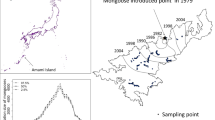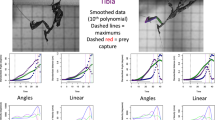Abstract
Feeding behavior is known to be modulated as prey properties change. During prey capture, external prey properties, including size and mobility, are likely some of the most important components in predator–prey interactions. Whereas prey size has been demonstrated to elicit modulation of jaw movements during capture, how prey speed affects the approach and capture of prey remains unknown. We quantified the kinematics associated with movements of both the feeding and locomotor systems during prey capture in a lizard, Gerrhosaurus major, while facing prey differing in size and mobility (newborn mice, grasshoppers, and mealworms). Our data show that the feeding and locomotor systems were recruited differently in response to changes in the size or speed of the prey. The timing of jaw movements and of the positioning of the head are affected by changes in prey size—and speed, to a lesser extent. Changes in prey speed resulted in concomitant changes in the speed of strike and an early and greater elevation of the neck. External prey properties, and prey mobility in particular, are relevant in predator–prey interactions and elicit specific responses in different functional systems.






Similar content being viewed by others
References
Agrawal KR, Lucas PW, Bruce IC, Prinz JF (1998) Food properties that influence neuromuscular activity during human mastication. J Dent Res 77:1931–1938
Anderson CW (1993) The modulation of feeding behavior in response to prey type in the frog Rana pipiens. J Exp Biol 179:1–12
Anderson CW, Nishikawa KC (1993) A prey-type dependent hypoglossal feedback system in the frog Rana pipiens. Brain Behav Evol 42:189–196
Berkhoudt H (1979) The morphology and distribution of cutaneous mechanoreceptors (Herbst and Grandry corpuscles) in bill and tongue of the Mallard (Anas Platyrhynchos L.). Neth J Zool 30:1–34
Cooper WE Jr (1990) Prey odor detection by Teiid and Lacertid lizards and the relationships of prey odor detection to foraging mode in lizard families. Copeia 1990:237–242
Cooper WE Jr (1992) Prey odor discrimination and poststrike elevation in tongue flicking by a Cordylid lizard, Gerrhosaurus nigrolineatus. Copeia 1992:146–154
Cooper WE Jr (1994) Chemical discrimination by tongue-flicking in lizards: a review with hypothesis on its origin and its ecological and phylogenetic relationships. J Chem Ecol 20:439–487
Cooper WE Jr, Perez-Melado V (2001) Location of fruit using only airborne odor cues by a lizard. Physiol Behav 74:339–342
Cooper WE Jr, Steele LJ (1999) Lingually mediated discriminations among prey chemicals and control stimuli in Cordyliform lizards: presence in a Gerrhosaurid and absence in two Cordylids. Herpetologica 55:361–368
Deban SM (1997) Modulation of prey-capture behavior in the plethodontid salamander Ensattina eschscholtzii. J Exp Biol 200:1951–1964
Delheusy V, Bels VL (1992) Kinematics of feeding behaviour in Oplurus cuvieri (Reptilia: Iguanidae). J Exp Biol 170:155–186
Elias JA, McBrayer LD, Reilly SM (2000) Prey transport kinematics in Tupinambis teguixin and Varanus exanthematicus: conservation of feeding behavior in ‘chemosensory-tongued’ lizards. J Exp Biol 203:791–801
Halpern M, Martinez-Marcos A (2003) Structure and function of the vomeronasal system: an update. Prog Neurobiol 70:245–318
Hartley R, Sturm P (1997) Triangulation. Comput Vis Image Underst 68:146–157
Herrel A, Cleuren J, De Vree F (1996) Kinematics of feeding in the lizard Agama stellio. J Exp Biol 199:1727–1742
Herrel A, Verstappen M, De Vree F (1999) Modulatory complexity of the feeding repertoire in Scincid lizards. J Comp Physiol 185:501–518
Herrel A, Huyghe K, Vanhooydonck B, Backeljau T, Breugelmans K, Grbac I (2008) Rapid large-scale evolutionary divergence in morphology and performance associated with exploitation of a different dietary resource. PNAS 105:4792–4795
Higham TE (2007) The integration of locomotion and prey capture in vertebrates: morphology, behavior and performance. Integr Comp Biol 47:82–95
Iwasaki S (1990) Fine structure of the dorsal lingual epithelium of the lizard Gekko japonicus (Lacertilia, Gekkonidae). Am J Anat 187:12–20
Iwasaki S (2002) Evolution of the structure and function of the vertebrate tongue. J Anat 201:1–13
Kaufman JD, Burghardt GM, Phillips JA (1996) Sensory cues and foraging decisions in a large carnivorous lizard, Varanus albigularis. Anim Behav 52:727–736
Kohlsdorf T, Grizante MB, Navas CA, Herrel A (2008) Head shape evolution in Tropidurinae lizards: does locomotion constrain diet? J Evol Biol 21:781–790
Lappin AK, German M (2005) Feeding behavior modulation in the leopard-lizard (Gambelia wislizenii): effects of noxious versus innocuous prey. Zoology 108:287–295
Lucas PW (2004) Dental functional morphology: how teeth work. Cambridge University Press, Cambridge
Moermond TC (1981) Prey-attack behavior of Anolis lizards. Z Tierpsychol 56:128–136
Montuelle SJ, Daghfous G, Bels VL (2008) Effects of locomotor approach on feeding kinematics in the green Anole (Anolis carolinensis). J Exp Zool 309A:563–567
Montuelle SJ, Herrel A, Libourel P-A, Reveret L, Bels VL (2009a) Locomotor-feeding coupling during prey capture in a lizard (Gerrhosaurus major): effects of prehension mode. J Exp Biol 212:768–777
Montuelle SJ, Herrel A, Schaerlaeken V, Metzger K, Mutuyeyezu A, Bels VL (2009b) Inertial feeding in the teiid lizard Tupinambis merianae: the effect of prey size on the movements of hyolingual apparatus and the cranio-cervical system. J Exp Biol 212:2501–2510
Ott M, Ostheim J, Sherbrooke WC (2004) Prey snapping and visual distance estimation in Texas horned lizards, Phrynosoma cornutum. J Exp Biol 207:3067–3072
Popowics TE, Herring SW (2006) Teeth, jaws and muscles in mammalian mastication. In: Bels VL (ed) Feeding in domestic vertebrates: from structure to behaviour. CABI Publishing, Oxfordshire
Reilly SM, McBrayer LD (2007) Prey-capture and processing behaviour and the evolution of lingual and sensory characteristics: divergences and convergences in lizard feeding biology. In: Reilly SM, McBrayer LD, Miles DB (eds) Lizard ecology: the evolutionary consequences of foraging mode. Cambridge University Press, New York, pp 302–333
Reilly SM, McBrayer LD, Miles DB (2007) Lizard ecology: the evolutionary consequences of foraging mode. Cambridge University Press, New York
Ross CF, Eckhardt A, Herrel A, Hylander WL, Metzger KA, Schaerlaeken V, Washington RL, Williams SH (2007) Modulation of intra-oral processing in mammals and lepidosaurs. Integr Comp Biol 47:118–136
Schaerlaeken V, Meyers JJ, Herrel A (2007) Modulation of prey capture kinematics and the role of lingual sensory feedback in the lizard Pogona vitticeps. Zoology 110:127–138
Schwenk K (1985) Occurence, distribution and functional significance of taste buds in lizards. Copeia 1985:91–101
Schwenk K (1993) Are Geckos olfactory specialists? J Zool Lond 229:289–302
Schwenk K (1995) Of tongue and noses: chemoreception in lizards and snakes. TREE 10:7–12
Schwenk K (2000) Feeding: form, function and evolution in Tetrapod vertebrates. Academic Press, New York
Smith TL, Kardong KV, Bels VL (1999) Prey capture behavior in the blue-tongued skink, Tiliqua scincoides. J Herp 33:362–369
Toubeau G, Cotman C, Bels VL (1994) Morphological and kinematic study of the tongue and buccal cavity in the lizard Anguis fragilis (Reptilia: Anguidae). Anat Rec 240:423–433
Urbani JM, Bels VL (1995) Feeding behavior in two scleroglossan lizards: Lacerta viridis (Lacertidae) and Zonosaurus laticaudatus (Cordylidae). J Zool Lond 236:265–290
Valdez CM, Nishikawa KC (1997) Sensory modulation and behavioral choice during feeding in the Australian frog, Cyclorana novaehollandiae. J Comp Physiol 180A:187–202
Vanhooydonck B, Herrel A, Van Damme R (2007) Interactions between habitat use, behaviour and the trophic niche of Lacertid lizards. In: Reilly SM, McBrayer LD, Miles DB (eds) Lizard ecology: the evolutionary consequences of foraging mode. Cambridge University Press, New York, pp 427–449
Vincent SE, Moon BR, Shine R, Herrel A (2006) The functional meaning of “prey size” in water snakes (Nerodia fasciata, Colubridae). Oecologia 147:204–211
Acknowledgments
This work is part of the PhD project of Stéphane Montuelle and is supported by the Legs Prévost (MNHN), ANR 06-BLAN-0132-02 and Phymep Corporation. The authors would like to thank ANR project Kameleon (ARA 05-MMSA-0002 “Masse de Données”) which provided the opportunity to use the synchronized camera set up at the Plateau Technique ‘Biologie des Organismes’ (dpt. EGB ‘Ecologie et Gestion de la Biodiversité’, MNHN). We also would like to thank Caroline Simonis for her constructive comments and suggestions on data analysis. Finally, S. M. would like to thank Prof J. Losos for welcoming him at the Losos Lab (Harvard University, Cambridge, MA, USA), during the writing of this manuscript.
Author information
Authors and Affiliations
Corresponding author
Electronic supplementary material
Below is the link to the electronic supplementary material.
Rights and permissions
About this article
Cite this article
Montuelle, S.J., Herrel, A., Libourel, PA. et al. Separating the effects of prey size and speed on the kinematics of prey capture in the omnivorous lizard Gerrhosaurus major . J Comp Physiol A 196, 491–499 (2010). https://doi.org/10.1007/s00359-010-0537-1
Received:
Revised:
Accepted:
Published:
Issue Date:
DOI: https://doi.org/10.1007/s00359-010-0537-1




